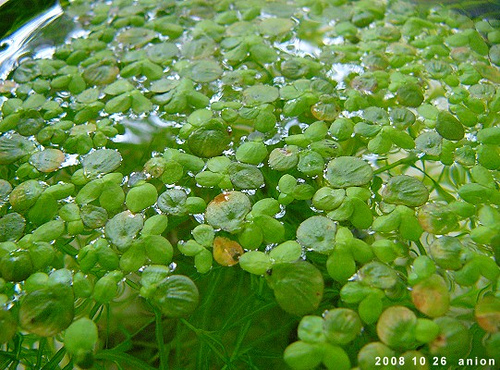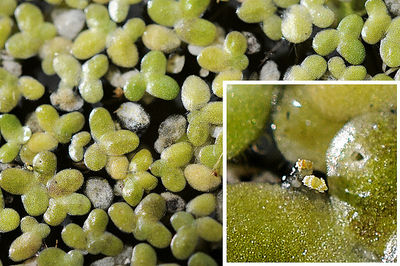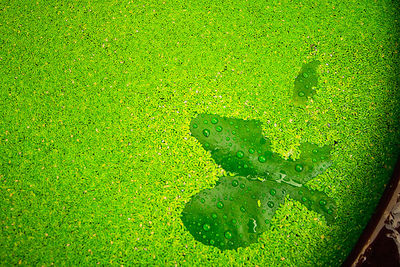Duckweed: Difference between revisions
MarkDilley (talk | contribs) (move right justified image above category breadcrumbing) |
(→Links) |
||
| Line 56: | Line 56: | ||
* Duckweed as a feed supplement for livestock [http://www.mobot.org/jwcross/duckweed/feed-supplement.htm] | * Duckweed as a feed supplement for livestock [http://www.mobot.org/jwcross/duckweed/feed-supplement.htm] | ||
* Older patent with many details on duckweed for human consumption [http://www.google.com/patents?id=Zo8mAAAAEBAJ&dq=5269819] | * Older patent with many details on duckweed for human consumption [http://www.google.com/patents?id=Zo8mAAAAEBAJ&dq=5269819] | ||
* Integrated Tilapia & Duckweed [[Aquaponics]] System [http://www.fishfarming.com/ | * Integrated Tilapia & Duckweed [[Aquaponics]] System [http://www.fishfarming.com/duckweed.html] | ||
* Manual for the use of biodigester effluent and ponds for duckweed production (from Vietnam) [http://www.fao.org/WAICENT/FAOINFO/AGRICULT/AGA/AGAP/FRG/Recycle/dweed/mandw.htm] | * Manual for the use of biodigester effluent and ponds for duckweed production (from Vietnam) [http://www.fao.org/WAICENT/FAOINFO/AGRICULT/AGA/AGAP/FRG/Recycle/dweed/mandw.htm] | ||
* Biofuels Wiki: [http://www.biofuelswiki.org/Home/Duckweed Duckweed] | * Biofuels Wiki: [http://www.biofuelswiki.org/Home/Duckweed Duckweed] | ||
Revision as of 04:20, 16 September 2015
Introduction
Duckweed (lemnaceae, water lentils) family are the smallest flowering plants and probably the fastest growing plant, capable of doubling its weight in 24 hours.
Duckweed grows well in still water, with a supply of mineral nutrients such as hydroponic solution or organic nutrient such as compost tea, or the fish effluent from aquaponics.
Because of the very high productivity per surface area, duckweed holds great potential for future global villages. This tiny aquatic plant has tremendous potential for cleaning up pollution, combating global warming and feeding the world.
Integrated Farming
According to research from the Tropical Ecological Farm, College of Agriculture and Forestry in Ho Chi Minh city, "It is unique amongst plants in that its protein content can be manipulated according the nitrogen content of the water in which it is growing. This is important because it integrates with the biodigester.
It is the ideal water plant to introduce into an integrated farming system because it can use the nitrogen in the effluent coming from the biodigester to enrich its protein content to a level only slightly lower than Soya Bean, approaching 35%. In terms of protein production, grown under ideal conditions in can produce 10 tonnes of protein per hectare per year. This compares with Soya bean which produces less than 1 tonne per year.
Duckweed as food
Depending on strain and growing conditions, duckweeds can have very high protein content of up to 50% of dry mass. High levels of vitamins are also present. The taste is remotely similar to spinach. Duckweeds have historically played a role in some east Asian cuisines (Wolffia genus). Because of rapid growth and ease of cultivation, duckweeds for consumption by animals and humans are now getting more attention.
Human food and the anaerobe problem: Duckweed can be eaten in salads or soups, on a sandwich or as a component of vegetable spread (or as a substitute for: lettuce, spinach, water cress, alfalfa, ... ?). If grown for human consumption, careful attention should be paid to the possible presence of anaerobes and other bacteria (= does this pass the smell test ?). The dense covering of duckweed at the water surface can block sunlight, often leading to absence of photosynthesis and consequent anoxic conditions in deeper levels and favoring anaerobic bacteria. A possible fix is the use of an air stone or other aeration, although this might disturb the duckweed which needs still water. After harvest, duckweed can be lacto-fermented which would quickly destroy all potential pathogens and leave only the lacto-fermenting bacteria (also see: silage).
For bio-energy
Duckweed produces biomass faster than any other flowering plant. It has clear potential as an alternative for biofuel production.
Duckweed ethanol: Duckweed can produce appreciable quantities of starch that can be readily fermented into ethanol. The total starch content of duckweed can vary from 3-75% of the dry weight depending on trains and species. Other factors like nutrients and concentration play a large role in the accumulation of starch in duckweed. Some species like Spirodela polyrrhiza combined with swine wastewater can contain a starch content of up to 46%. Duckweed has a great potential for the development of an environmentally friendly, economically viable ethanol production.
Biogas:: closed-loop system: use effluent from digester to grow duckweed, then use duckweed in biogas digester.
Gasification:: dried feedstock can be burned or gasified. Ash can be used as fertilizer on the duckweed pond. Biochar as another useful product of pyrolysis.
Other applications
Bio-sensors:
Duckweeds are used for the detection of heavy metals and organic contaminants.
Bioremediation: Living Machines for cleaning wastewater, such as blackwater (domestic sewage). To remove heavy metal contaminations, grow duckweed on contaminated water, harvest, dry. Then grow certain fungi on the biomass: fungi take up heavy metals. Carefully burn fungi, then the ash contains highly concentrated heavy metals, ready for safe disposal.
Biomining: of phosphorus and other minerals/nutrients from wastewater.
Animal food: (see above) food for fish (tilapia), chickens, pigs and of course ducks! Duckweed integrates very nicely into aquaponics. It can provide all the protein needs for some breeds.
Pharmaceuticals: Genetic modifications can give duckweeds new characteristics, such as pharmaceutical proteins and other biopharmaceuticals.
In Space: food production in bioregenerative life support systems in space. [1]
Organic Duckweed
Nutrients may be supplied from sources such as cattle dung, pig waste, human urine, biogas plant slurry, leachate from silage or compost or other organic matter in slurry form.
Links
- Very comprehensive manual on duckweed aquaculture [2] - internal .pdf backup copy here: [3]
- Cross, J.W. (2006). The Charms of Duckweed. [4]
- Wikipedia entry on duckweed in general and on Wolffia
- July 2008 article on Treehugger [5]
- Duckweed as a Primary Feedstock for Aquaculture [6]
- Duckweed as a feed supplement for livestock [7]
- Older patent with many details on duckweed for human consumption [8]
- Integrated Tilapia & Duckweed Aquaponics System [9]
- Manual for the use of biodigester effluent and ponds for duckweed production (from Vietnam) [10]
- Biofuels Wiki: Duckweed


